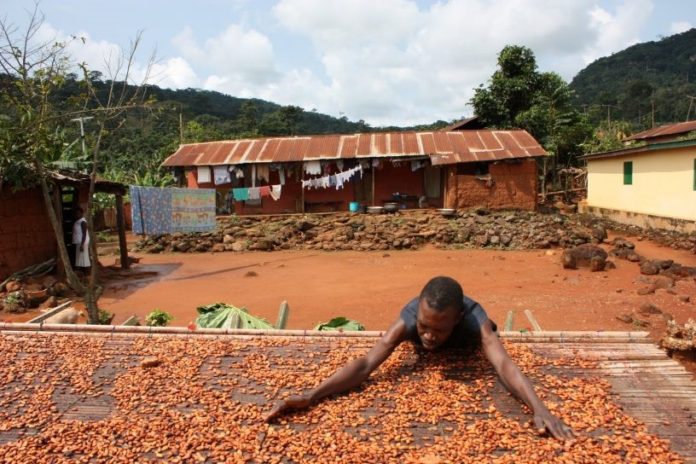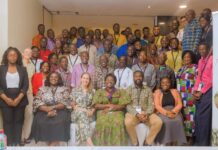Last year many in business, including the authors, correctly predicted the problems which are now besetting the Living Income Differential in West Africa. Now in its new initiatives on cocoa and supply chain due diligence, our view is that the EU risks doubling down on failure. We argue that what is needed is a fundamental re-think of how we approach the challenges of supply chains based on hard-headed analysis and action-focused collaboration.
By Dr. Peter Stanbury and Toby Webb
Why the LID is failing?
The Living Income Differential (LID) was introduced in 2019 by the governments of Ghana and Cote d’Ivoire, to apply a premium of $400/ tonne on the export price of cocoa from the 2020/21 crop. This additional revenue was intended to increase the incomes of farming families to help them achieve a living income.
A year on, it is clear from many reports that the LID is not working – as a Bloomberg report put it, the governments’ “attempt to exert control over prices is backfiring.” The cocoa trade journal, Confectionary News went further and concluded that the LID has actually made the situation worse for smallholder farmers, who are seeing their incomes going down, not up.
The Covid pandemic has complicated the situation for the world’s chocolate business, but the reasons behind the struggles facing the LID were entirely predictable at its outset. Nor is not just hindsight: in January 2020 we published an analysis of the LID which identified precisely the problems which are now haunting it.
Our analysis last year pointed out that the success of the LID “relies on the effectiveness of state structures in the two host countries,” but that in both cases “this seems likely to be a challenge,” given the governance issues facing both countries.
In particular, there has been, we pointed out, historically no clarity on how much of the cocoa price actually gets paid to farmers, and no details had been provided about how the LID’s ‘stabilisation fund’ would actually work.
It seems that analysis was correct. An assessment of the rollout of the LID by market research firm IHS Markit undertaken in Autumn 2020 concluded that “there is very little transparency over exactly how the LID is being collected, where the money is being stored, and how it’s going to be spent.”
Findings from our own smallholder research, published in December, suggest things might actually be even more worrying – with allegations made in interviews that the LID is driving corruption.
We also pointed out that, in introducing a price premium on their cocoa, the governments of Ghana and Cote d’Ivoire were raising the challenge that “buyers may simply go elsewhere for their cocoa beans.” Again, unfortunately, but entirely predictably, this is what has begun to happen.
This past November, it was reported that US manufacturer, Hershey, was buying significantly more of its cocoa through the ICE commodities futures exchange. Reuters quoted one broker as saying that “the exchange right now is the cheapest place to buy cocoa.” Other reports suggested that Mars was adopting a similar strategy.
The response of the Ghanaian and Ivoirian governments has been to cancel “all of the sustainability programs Hershey is involved indirectly or indirectly.” It is hard to see how this step is in the best interests of farmers who benefitted from those programmes.
Finally, we also predicted that the promise of rising prices risked “increased production of cocoa” as farmers sought to increase their incomes. Again, this is exactly what has happened, with a clear cause of the cocoa surplus being “increased production”, in West Africa.
In this case, again, the risk, therefore, is that the LID might actually have made the situation worse in Ghana and Cote d’Ivoire, in particular in relation to environmental issues. In our article last year, we cited a World Bank report which stated that “forest degradation and deforestation are driven primarily by cocoa farm expansion.” It is entirely possible, therefore, that the increase in cocoa production driven by the LID has in fact led to further damage to sensitive landscapes.
A poorly considered policy can make things worse
Given the manifest failure, to date, of the LID, it is a matter of considerable concern that the lessons arising from it have not, apparently, been learned. Indeed, initiatives are underway which demonstrate both the same commendable aspiration as the LID, but also a similar degree of political and economic naivety
The first is the EU’s Sustainable Cocoa Initiative launched last Autumn. According to the EU Commission’s press release, this promises to promote a “dialogue [which] aims to deliver concrete recommendations to advance sustainability across the cocoa supply chain through collective action and partnerships.” Yet in none of the information available about this initiative is there any mention of the need to address issues which we know from the experience of the LID are critical.
Specifically, nowhere is the importance raised of improving domestic governance and transparency in Ghana and Cote d’Ivoire, or the challenge which will be posed by simple market forces if the price of West African cocoa rises.
Particularly naïve is “the Commission’s ‘zero-tolerance approach to child labour.” It was clear from a number of interviews undertaken last year for our smallholder research project that work to eliminate child labour from cocoa production has not ‘solved’ child labour, but simply meant that they work in fields other than those where cocoa is produced. Child labour is clearly an issue of poverty, not a particular crop.
The second is the plan announced last April by the European Commissioner for Justice to “introduce new rules on mandatory human rights and environmental due diligence in EU companies’ global supply chains.”
As with the LID, this idea seems like a straightforwardly good notion. If you have environmental and human rights challenges in supply chains, introduce laws to stop them. Yet like the LID, it ignores the huge and messy realities which will undermine, perhaps fatally, its chances of success.
Most practically there are the issues associated with extraterritorial jurisdiction; the process by which the behaviours of citizens (in this case corporate ones) of one country are governed in the territories of others. In the case of the potential supply chain due diligence legislation, this begs a range of questions. For example, what will happen when an allegation is raised? How will this be investigated? How will evidence be collected which would be capable of bearing the burden of proof in court? How might witnesses be interviewed, and how would they testify in court? (At the other end of the process, if compensation were to be paid, what structures will assure that it is disbursed honestly and fairly?
But equally important is the message that this approach sends to governments of the global south. Effectively, in taking on the policing of its companies’ supply chains, the EU is saying to those governments “we don’t think you have the capability or willingness effectively to police environmental or human rights in your country, so we will do it for you.” In the long run, the only way in which people’s lives in developing countries will improve, and environmental protections will be upheld is by improving those countries’ systems of governance. Extraterritorial regulation on the part of the EU or others runs completely counter to the need. Moreover, it provides an excuse on the part of those governments to do nothing, and not to seek to improve over time.
Finally, there is the reality that the issues we see in supply chains are not necessarily caused by those supply chains. Child labour in West Africa is not ‘caused’ by the international cocoa trade, nor can the challenge of low incomes solved simply by a price hike. These challenges are born of wider societal structures, and it is only by addressing these contextual issues that the challenges faced in supply chains can be properly addressed.
For example, as Wageningen University’s 2019 paper made clear, farm size means that only a minority of smallholder commodity farmers could ever earn a living income from primary commodity production. Certainly, significant changes are needed in the way international supply chains operate, as we advocate.
Therefore, it will only be by engaging with, understanding, and addressing fundamental societal issues in origin countries that the human rights and environmental challenges we see will be sustainably addressed.
Doing the right thing, not the simple one
And it is this last point which is perhaps the most material. The international community and campaign organisations continue to focus on ill-thought-through ‘quick fixes’ to challenges in global supply chains rather than on understanding the complex and messy issues which need to be addressed if systemic change is genuine to be achieved.
We have long argued that there is a fundamental need for a more rigorous analysis of the challenges faced in international supply chains. In the case of the LID, as we argued last year, this means real and deep engagement with the detail of why governance in Cote d’Ivoire and Ghana is problematic and, even more importantly, to understand what needs to be done to improve it.
In the case of supply chain due diligence, the focus should rather be on supporting the development of a good judicial process in origin countries, than on creating EU-based regulation. This kind of work has precedent, but is not media or politically friendly, involves years of resources, training, and incentives development, and is always woefully underfunded by donor governments and their agencies.
However, as we have also long argued, there is also a need for better collaboration between different actors if we are to achieve systemic change. Indeed, core to the rationale of our smallholder action research project is to facilitate cooperation between different types of organisation, and across different commodity supply chains. This might seem curious given the apparently countless ‘multi-stakeholder dialogues’, and ‘collaborations’ that seem to exist, but it is apparent that most of these fail actually to gain traction in achieving real change on the ground.
In an earlier article, we outlined how a Collaborative Development Governance approach could inform just how collaboration between companies, NGOs, IGOs, and others can make a real difference on the ground. This is achieved by joining up project-based approaches into something more systemic.
It is our view that ‘collaboration’ as currently posited often fails to address the fundamental questions behind a particular challenge (in this case poverty, the quality of institutions, and governance). This failure to understand, in particular, the incentives of different parties and the political economy within which they exist, leads to well-intentioned initiatives having unintended consequences. The cocoa LID being a case in point.
For progress, improve the public policy agenda
There is a need to engage the public policy agenda to ensure that it is genuinely supportive of the goal of developing sustainable smallholder supply chains in Cocoa. Better research is needed to ensure that this happens.
Analysis should explore how to ensure that initiatives like the Sustainable Cocoa Initiative are better informed and more realistic. For example, how might issues such as governance, transparency, and capacity in Cote d’Ivoire and Ghana affect the impact of the initiative, and what might be done to address these things?
Secondly, further independent cocoa industry research should examine how northern’ governments’ strategies for international development, trade and investment can best support the development of sustainable supply chains. Wholesale changes in issues like tariff policy are not going to be feasible, but small changes in existing regimes may be possible which would encourage more processing of raw agricultural products in origin countries. This will provide more resources to support smallholders and others in agricultural supply chains. It would also provide much-needed tax revenue which if smartly directed, could improve local and national institutions and overall economic development.
Time to take account of the complexity
It is for these reasons, to undertake properly rigorous research, and to facilitate practical action for which we have established the Innovation Accelerator. This will build on the findings of our research so far, which has clearly identified those issues which need to be addressed if commodity supply chains are to be genuinely sustainable. Our key areas of focus are the following:
A country issue matrix
It is clear from our research what issues need to be addressed at the field level: working with farmers themselves; ensuring good governance of cooperatives; engaging key elements of the host government; and addressing the downstream supply chain between farm and port. We also know that a clear challenge is a lack of collaboration and join-up between different interventions.
In-depth research is needed to explore, in a range of geographic locations how to apply this issue matrix in order to develop a clear understanding of what needs to be done in each place. This work allows the mapping of who is operating there, and what they are doing. This will enable a more joined-up approach.
This will mean that individual programmes will be able to understand in more detail the wider context in which they exist and collaborate more effectively. Such research will enable a move from the current project-based approach to something more systematic.
From the perspective of procuring companies, consumer brands and others will be able to focus in more detail on the issues which affect their supply chains from different parts of the world. It will help them cut through the noise often surrounding these issues. The story behind where things come from is, as we know, ever more important and relevant. Direct sourcing provides traceability, which will be much needed as companies seek to lower GHGs and improve biodiversity in supply chains.
A sustainable goods marketplace
Outside certification schemes like Fairtrade, no system aligned with corporate procurement exists to match those wanting to sell sustainably produced goods with those wishing to buy them. Self-evidently, this is highly inefficient. An approach to bridge this gap, once properly explored, and effectively functioning, both help smallholders gain better access to better markets, will help sourcing companies demonstrate concrete delivery against their SDG commitments.
Even from the relatively small research process, we have undertaken so far, it is clear that there are a number of inefficiencies in the production and marketing of sustainably produced goods. Even within individual companies (albeit very large ones) there seems to be no internal mapping of what sustainably-produced commodities are produced, and where. If this is the case even within individual companies, then how much more inefficiencies will exist across the entire smallholder sustainability ‘industry’?
The next phase of our research will research how to develop an effective mechanism to bring sellers of sustainably produced goods together with buyers of them. As with the risk mapping project, our aim will be to start with a pilot process in a limited number of places and then expand subsequently.
We are conscious that such an idea as this Sustainable Goods Marketplace is an ambitious one. The reality, however, is that if smallholder supply chains are ever to be sustainable, an alternate market mechanism such as that which we are proposing must work. Only by aiming at systemic change in the way these supply chains are handled can issues such as a living income and environmental degradation be properly addressed.
However, it is our strong view that comprehensive research into how the Marketplace might work, in particular, the challenges and unintended consequences that may result may be tough, but it is important to work that needs to be undertaken. We have not seen this explored elsewhere, identifying the issues which need to be addressed from farming communities at one end to corporate procurement functions at the other.








